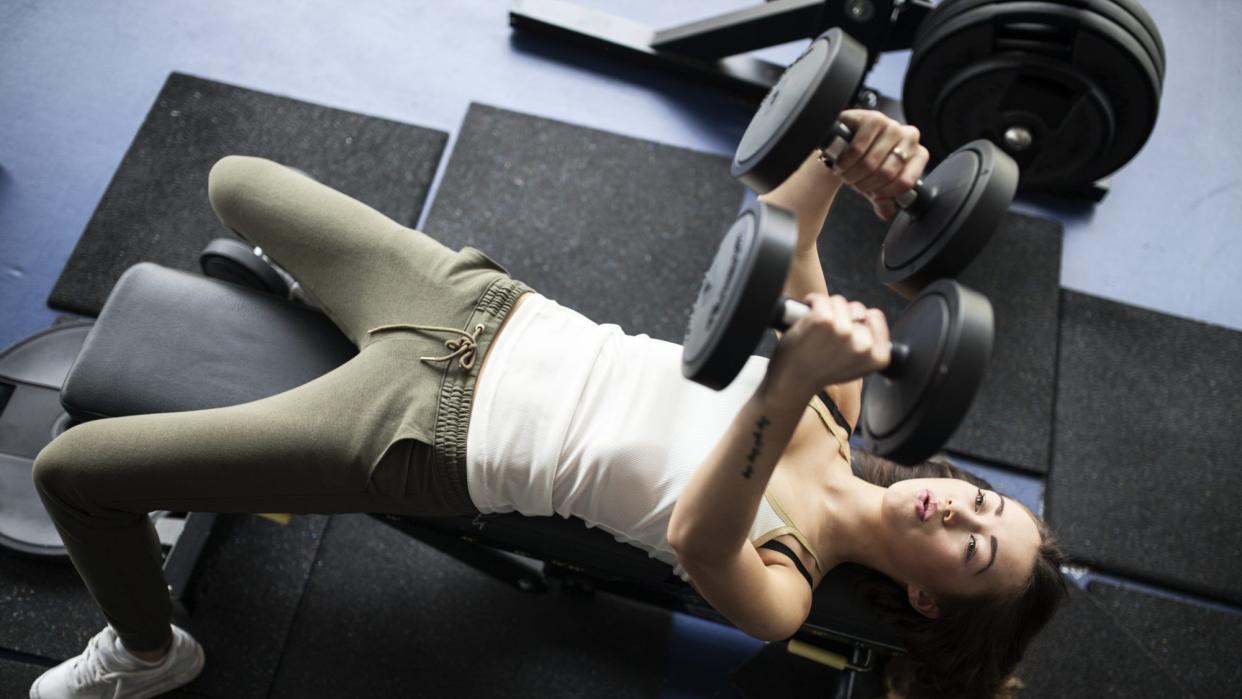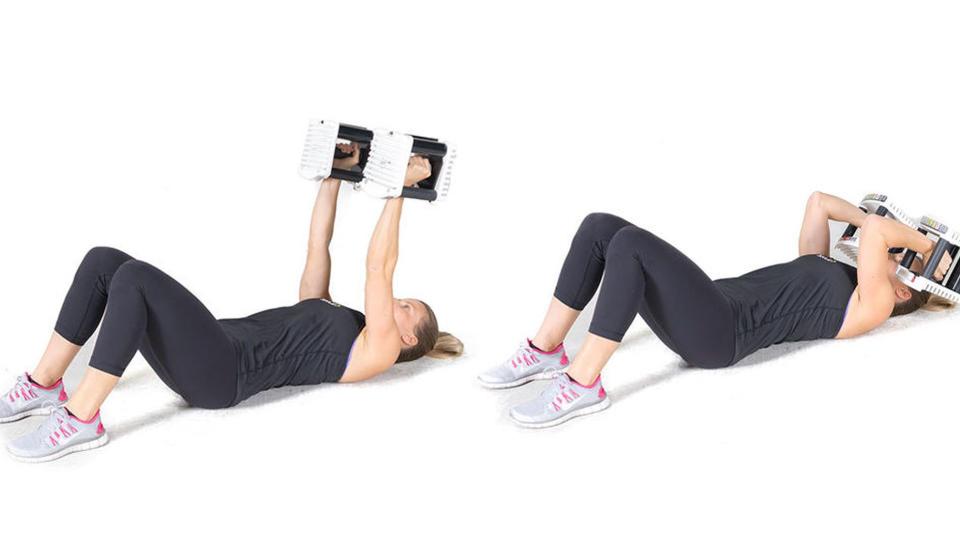How to Do Skull Crushers, According to Trainers

efenzi/Getty Images
You know when you're lying flat in bed on your phone, holding it up over your face, and your arms start to burn? Well, you're kinda doing a skull crusher.
Here's everything you need to know about skull crushers, the tricep exercise that doesn't just sound badass but will make you feel that way as well.
What Are Skull Crushers?
Skull crushers, aka lying triceps extensions, are a move traditionally performed lying down on a bench or exercise mat with a pair of dumbbells or an EZ curl bar (just one of many barbells at the gym). You hold the weight over your face (hence, the name "skull crusher") with elbows pointing up, then use your triceps (the muscles on the back of your upper arm) to straighten your elbow and pull the weight toward the ceiling.
The Benefits of Skull Crushers
By strengthening the triceps, skull crushers help make everyday functional movements easier.
They'll help you out during many other strength movements.
"Triceps help your overall pushing strength and are the key extensor of the elbow joint," explains Riley O'Donnell, a NASM-certified personal trainer, and instructor at Fhitting Room, a HIIT studio in New York City. "So if you're trying to get stronger in your overhead presses, chest/bench presses or push-ups, strengthening your triceps will help you reach your goals."
You'll get better at push-ups.
Skull crushers enhance pushing movements because they train your body to load weight with your elbows in a flexed position (a bent arm), and press the weight away into a locked out arm, says O'Donnell. "When we are pushing things, we not only need to engage our shoulders, chest, and core, but we need to be able to powerfully extend the elbow," she says. So if you've been struggling with push-ups, these are a great way to make them feel easier.
You'll target your triceps without any interference.
Unlike other arm and upper-body exercises, skull crushers make triceps the primary muscle involved, so you're better able to target these smaller arm muscles. "The triceps rarely take the lead, in comparison with biceps for lifting or holding, or glutes for walking or standing," says Ash Wilking, CFSC, FRC, Nike trainer and instructor at Rumble, a boxing studio. "In other words, they assist larger muscle groups in performing countless movements both in strength training and everyday activity," says Wilking.
You can do them with limited mobility.
But by solely utilizing the elbow joint, skull crushers isolate the triceps, which isn't true even for many triceps-dominant exercises, says O'Donnell. "For example, standing triceps extensions and triceps dips require shoulder mobility that not everyone has," she says. Because of this, skull crushers are best suited for those who have a limited range of motion in the shoulders and want to strengthen their triceps.
...Or an injury.
In addition to building triceps strength, skull crushers are beneficial for those who want a low-impact arm exercise or are working around an injury. "By lying on your back with the weight overhead, you put the primary focus on the triceps and remove pressure from other joints, like your wrists (in push-ups) or lower back (in bent-over kickbacks)," Wilking explains.
You'll build up grip strength.
Skull crushers also play a large role in improving grip strength by preventing you from dropping the weight and literally crushing your head. "When performing skull crushers, whether it's with a pair of dumbbells, a barbell or a plate, it's important to keep your wrists straight. It can be tempting during this movement to break the wrist because it feels easier to hold the weight, but focusing on keeping your wrists straight improves your grip strength," says O'Donnell. (Need another lesson in grip strength? Try this battle rope workout.)

How to Do Skull Crushers
There are two ways to do skull crushers: using a bench or an exercise mat. "By using a bench, you can place your feet on the ground, requiring different engagement in your lower body and core; engaging your glutes, tucking your pelvis, and keeping your core tight and ribs down requires thoughtful effort," says Wilking. If you're lying on a mat, your feet are also flat on the floor, but your knees are much more bent, allowing you to tilt your pelvis and create a better connection with your rib cage, she says. "This connection will limit shoulder movement and create true isolation of the triceps," she says.
So, if you're new to skull crushers, try doing them on a mat versus the bench so you can move with more control and truly engage the triceps throughout the eccentric (lowering) and concentric (lifting) phases of the movement, recommends Chris Pabon, a NASM-certified personal trainer and fitness manager at Blink Fitness. "You will sacrifice some range of motion, but you'll learn good form," he says.
To ensure you're doing skull crushers with proper form, O'Donnell also suggests practicing the movement with just your body weight and slowly adding weight. That means using a weight that's challenging but something you can use to complete 10 to 12 reps with proper form. You can also use one dumbbell, gripping it with both hands, to start, before trying one weight in each hand.
A. Hold a dumbbell in each hand and lie faceup on an exercise mat (or bench) with knees bent and feet flat on the floor.
B. Extend arms above the chest with palms facing each other. Engage glutes and pull the rib cage down to prevent arching the low back.
C. Tucking elbows in and pressing shoulders down, slowly bend elbows to lower the dumbbells about an inch above the forehead on either side of the head. Avoid moving upper arms and anchor shoulders down to engage the lats, isolating the triceps as the weights lower.
D. With control, lift arms back up.
Decline Skull Crushers
Pabon says changing the incline on the bench can engage specific heads (read: parts) of the triceps a bit more than others. For example, using a decline bench (with your head lower than your feet) will recruit more activation from the lateral tricep head, which is toward the outside of your arm, says Pabon. Here's exactly how to do decline skull crushers with a pair of dumbbells.
A. Hold a dumbbell in each hand and lie faceup on a decline bench with knees bent over the cushions and shins locked into place.
B. Extend arms above the chest with palms facing each other. Engage glutes and pull the rib cage down to prevent arching the low back.
C. Tucking elbows in and pressing shoulders down, slowly bend elbows to lower the dumbbells about an inch above the forehead on either side of the head. Avoid moving upper arms and anchor shoulders down to engage the lats, isolating the triceps as the weights lower.
D. With control, lift arms back up.
Incline Skull Crushers
Using an incline (with your head on the higher end) will work the long head of your triceps, which is toward the inside of your arm, says Pabon. Here's how to do it.
A. Adjust the bench to 30 degrees and lie faceup, holding a dumbbell in each hand and feet flat on the floor.
B. Extend arms above the chest with palms facing each other. Press back into the bench to prevent arching the low back.
C. Tucking elbows in and pressing shoulders down, slowly bend elbows to lower dumbbells behind the head.
D. With control, lift arms back up.
Dumbbells vs. EZ Bar Skull Crushers
Whether you're using a pair of dumbbells or an EZ curl bar, Pabon says form is generally the same. With an EZ bar, you want to make sure your hands are just inside shoulder width on the bar. Dumbbells are harder to control (since there are two of them), so you're likely to scale back on weight, whereas you might be able to lift heavier with an EZ bar, but they can help address any strength imbalances between your arms. If you have issues with pinning your elbows in, Pabon also says using an EZ bar instead of dumbbells can help correct this problem.
Skull Crusher Form Mistakes—and How to Fix Them
While skull crushers aren't complicated to master, they're a recipe for injury and pain if you're not doing them correctly. To help you get the most out of this triceps burner, here's a PSA on how to fix these easy-to-make mistakes. (Related: Beginner Exercises to Strengthen and Tone Your Arms)
1. Flaring Out the Elbows
As you're lowering the weights, it's tempting to flare your elbows out to make it easier on your triceps, but keeping the elbows in ensures you're maximizing burnout of these tiny-yet-mighty muscles. "Imagine your elbows are hugging a balloon to keep your elbows from flaring and that your upper arms are against a wall throughout the entire movement," says O'Donnell. This will help hold your upper body in place on the mat or bench.
Wilking also recommends this visual cue: "Imagine you're grabbing a steering wheel, turning your pinky fingers down and in, to help engage the lats."
Slowing down the movement can help, too. "Control the weight both ways—during the eccentric and concentric part of the movement. Injuries happen during deceleration and/or rotation usually, so really focusing on controlling that weight," says Pabon.
2. Shrugging the Shoulders
To truly isolate the triceps and ensure you're not using your shoulders or upper arms, O'Donnell says to pack your shoulders down, aka engage the lats. "When your lats aren't engaged, the tendency is to let your upper arm move during the skull crusher," explains O'Donnell. Tightening your core can also help stabilize the upper body, she says. "Because the skull crusher is performed on your back, your core is working to keep the ribcage knitted during the movement and the low back pressing into the floor or bench," she says. Knitting the rib cage means pulling the down and together, engaging the deep core muscles, to help prevent compressing the low back.
3. Arching the Low Back
This adds pressure to the low back, which can lead to pain and injury. Wilking suggests pulling your rib cage down into the floor to avoid them from flaring out. "Think about pressing your feet into the ground as hard as you possibly can and knitting your rib cage while pressing the back of your ribs into the floor or bench," says O'Donnell.
How to Add Skull Crushers to Your Workouts
Ready to flex? Trying 3-4 sets of 10-12 reps is a good place to start. Wilking suggests doing skull crushers in a superset workout with a biceps exercise on arm days. She also recommends using them as an active recovery movement. "For example, if you're doing a leg or full-body workout, use skull crushers while allowing your legs to recover between sets," says Wilking. Pabon says he usually does skull crushers on days when he's focusing on other "push" muscles, like chest or shoulder day. "It's a great way to really finish them [triceps] off after they've been used as secondary muscles for the first part of the workout," he says.

